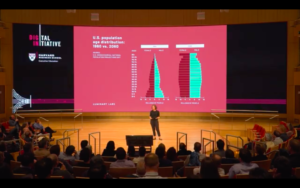Changing demographics will require organizations to rethink long-term expectations.
Organizations come to consultants for answers, and we take pride in defining problems and bringing solutions to bear. More often than not, the process begins with asking the right questions.
Luminary Labs CEO Sara Holoubek recently delivered a talk at the Harvard Business School’s Advanced Management Program, co-sponsored by the HBS Digital Initiative, where she offered a different way to think about long-term planning across sectors and industries. The talk, now available online, starts by reframing an important question. Instead of asking “How will the future of [the thing we’re working on] change humanity?,” organizations should ask “How will the future of humanity change [the thing we’re working on]?”
In the coming decades, an aging population and slowing population growth will impact everything — from geopolitics and the global economy to healthcare and the future of work. If you’re planning for 2030, predicting how technology will change is less helpful than understanding how demographics will change.
In the 20th century, booming population growth led to booming economic growth. The rise of the nuclear family boosted production and sales of consumer packaged goods, appliances, vehicles, and energy. But in the 21st century, things are changing. Global fertility rates are dropping, and the median age is increasing. The sandwich generation — those caring for children and older relatives at the same time — increasingly views multigenerational housing as a way to save time and money. (There goes the nuclear family.) For a view of the future, look at Japan, where nearly one-third of the population is over 65; the country’s population decreased by more than 1 million people between 2012 and 2017. The demographic shifts have resulted in slowing economic growth, growing labor shortages, increased spending on healthcare, and a shrinking tax base.
Slower population and economic growth can be a good thing for society and the environment — and even for businesses. But successfully adjusting to this new reality will require organizations to answer a big question: How do you plan for sustainability and prosperity when you can’t depend on growth?
The aging population will create opportunities for some sectors and industries, such as home health aides and even assistive robots. (When there are fewer people in the workforce, we’ll need more robots — and more upskilling and reskilling opportunities for aging human employees.) But some industries will struggle, and any organization that’s not prepared for changing demographics will face serious challenges.
We share updates and insights — including summaries and undercurrents from special events — in our weekly newsletter: Subscribe to the Lab Report.
Photo at top: Anna Dziubinska / Unsplash


